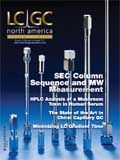Generous Results with MISER Chromatography
LCGC North America
An interview with Merck's Christopher Welch about high-throughput analysis using MISER chromatography and how it can boost your laboratory's productivity.
Merck's Christopher Welch spoke to Alasdair Matheson, editor of LCGC Europe, about high-throughput analysis using MISER chromatography and how it can boost your laboratory's productivity
What is MISER chromatography and when was this concept devised?
Welch: The acronym MISER stands for "multiple injections in a single experimental run." It's a form of high-throughput chromatographic analysis that we've been using here at Merck for about 10 years. MISER chromatography has received quite a bit of attention since our recent publication on the technique (1).

Christopher J. Welch Merck Research Laboratories
MISER chromatography is essentially flow injection analysis (FIA); the only difference is that on the way to a detector, the samples are passed through a chromatographic column, which provides minimally sufficient resolution of the peaks of interest, or for liquid chromatography–mass spectrometry (LC–MS) applications, resolution of the components of interest from interfering substances.
Basically, MISER is a very simple way to perform high-throughput analysis so that the entire experiment resides in a single chromatogram, thereby simplifying data analysis and interpretation. MISER doesn't work for every scenario, but in certain cases it greatly speeds up and simplifies the task of high-throughput analysis.
Why is this technique becoming more important for chromatographers?
Welch: Over the last few years there has been a big push toward the adoption of platform technologies that are, in effect, "solution engines" for certain classes of problems. At Merck, we have platforms for quickly finding the best reagents, additives, and conditions to use in a particular chemical reaction or purification. A variety of different conditions are screened in parallel, which generates lots of samples that have to be analyzed and interpreted before a conclusion can be drawn from the experiment.
Consequently, researchers are becoming burdened not only with an ever-increasing number of samples, but also with the need to organize the resulting data in a way that helps interpretation and decision making. MISER chromatography both speeds up analysis time, typically to less than 1 min for each sample, and greatly simplifies interpretation of the results by eliminating the need for the traditional steps of peak integration, data transfer, and graphing. With MISER chromatography, we like to say that the chromatogram is the graph.
What advantages does MISER chromatography have over other high-throughput techniques and what is unique about your approach?
Welch: The MISER approach is best suited for optimization workflows with large groups of samples containing different levels of the same principal components. We like to use it to support screening when we are trying to identify microplate wells where a particular product is being formed at high levels, or where an impurity is being reduced to very low levels. The use of MS detection allows individual components of interest to be extracted from the MISER chromatogram, or MISERgram. This provides a very effective visual readout for the experiment, allowing the researcher to quickly identify promising conditions for follow-up studies.
This visual simplicity is similar to that offered by the "old school" multiparallel planar separation techniques of thin-layer chromatography (TLC) or slab gel electrophoresis (SGE). The MISER technique is especially well suited for "needle in a haystack" screening scenarios, where only a very few "hits" may be turned up in the analysis of hundreds of samples. In this scenario, hits easily stand out from the surrounding misses. The technique doesn't work well for situations where very small differences in composition between samples must be measured, or where exact quantification is needed. The technique is also poorly suited for high-throughput screening approaches in which a different molecule of interest appears in each well, which is often the case in drug discovery. When it is possible, the speed and simplicity of the approach are so compelling that one gets used to designing experiments in such a way that MISER analysis can be used.
References
(1) C.J. Welch, X. Gong, W. Schaefer, E.C. Pratt, T. Brkovic, Z. Prizada, J.F. Cuff, and B. Kosjek, Tetrahedron:Asymmetry 21(13–14), 1674–1681 (2010).
This interview was edited for length and clarity.

Extracting Estrogenic Hormones Using Rotating Disk and Modified Clays
April 14th 2025University of Caldas and University of Chile researchers extracted estrogenic hormones from wastewater samples using rotating disk sorption extraction. After extraction, the concentrated analytes were measured using liquid chromatography coupled with photodiode array detection (HPLC-PDA).
Polysorbate Quantification and Degradation Analysis via LC and Charged Aerosol Detection
April 9th 2025Scientists from ThermoFisher Scientific published a review article in the Journal of Chromatography A that provided an overview of HPLC analysis using charged aerosol detection can help with polysorbate quantification.
Removing Double-Stranded RNA Impurities Using Chromatography
April 8th 2025Researchers from Agency for Science, Technology and Research in Singapore recently published a review article exploring how chromatography can be used to remove double-stranded RNA impurities during mRNA therapeutics production.








